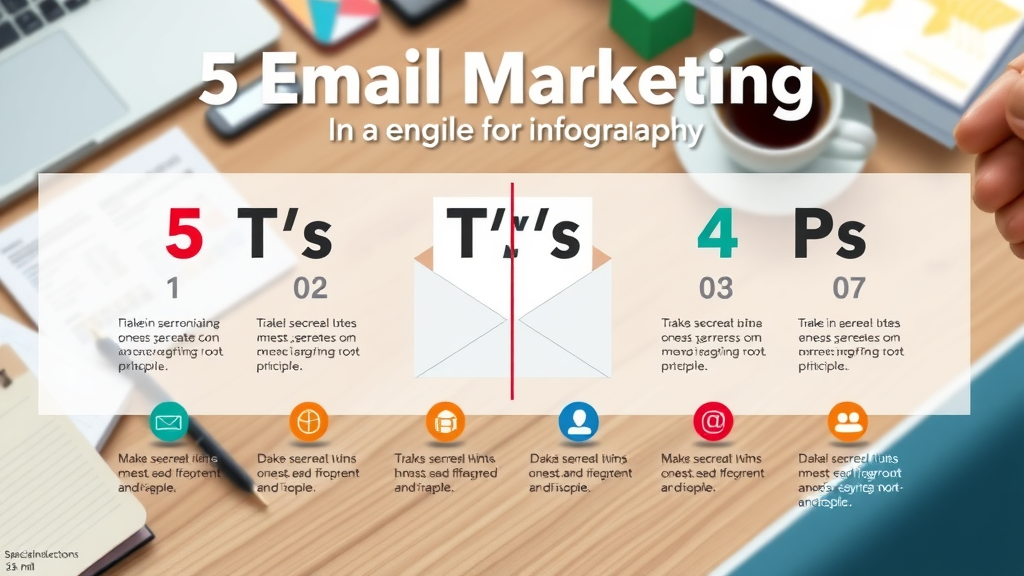Did you know that for every $1 spent on email marketing, the average return is $42 ? That’s not just impressive—it’s a game-changer. In a world where digital marketing trends seem to change overnight, one thing remains clear: email marketing campaigns are an unstoppable force for businesses aiming to drive sales and engage customers. This guide delivers practical tips, battle-tested strategies, and inspiring examples you can use to build email campaigns that truly deliver results. Get ready to transform the way you market, one successful email at a time.
- For every $1 spent on email marketing, the average return is $42 .

- Email marketing campaigns retain their power even as digital channels multiply, remaining a cornerstone of effective marketing strategies.
- This article equips you with actionable tips, proven strategies, and real-world examples to ensure your marketing campaigns are successful, measurable, and lucrative.
Email Marketing Campaigns: Why They Remain Essential for Sales Growth
Email marketing campaigns have stood the test of time because they deliver measurable ROI, adapt easily to evolving strategies, and put brands in direct contact with audiences. With inbox access, companies can bypass noisy social feeds and crowded ad spaces, driving engagement with tailored messages. For many businesses, marketing emails are the backbone of customer communication—from promoting new products and services to nurturing relationships and encouraging repeat purchases.
The financial upside is hard to ignore. Data-driven campaigns yield high open rates and conversion rates, often surpassing other digital marketing channels. Because email campaigns directly reach segmented audiences, every message can target the right person with the right offer at precisely the right time. Whether you’re launching a discount code, announcing events, or sending informative newsletters, a robust email marketing campaign boosts brand awareness and increases sales in ways few other mediums can match. Real-world examples continuously prove that consistent, well-planned marketing campaigns deliver results and provide a reliable, scalable way to fuel business growth.
Unlocking Email Marketing Success: What You’ll Learn
- How to design email marketing campaigns that consistently generate revenue
- Key components of a successful email marketing campaign , from crafting effective subject lines to optimizing your email copy
- Essential marketing campaign strategies tailored for different audiences and business goals
- Advanced segmentation, automation tactics, and performance measurement metrics
- Best practices from top-performing marketing campaigns you can implement immediately
- Actionable tips to optimize every marketing email for higher engagement and ROI
Demystifying Email Marketing Campaigns: Core Principles and Fundamentals
What Makes an Email Marketing Campaign Successful?
An email marketing campaign is a coordinated series of emails designed to achieve a specific business goal—be it boosting sales, building brand awareness, or driving traffic to your site. One-off blasts have their place, but true campaign success hinges on a holistic marketing strategy that starts with audience segmentation, aligns messaging across all emails, and delivers a compelling call-to-action (CTA). Defining clear objectives at the outset is essential: every email, subject line, and offer must serve a unified purpose.
Marketing campaigns succeed when messaging resonates with target segments, delivering value at every touchpoint. Whether you choose to run a welcome series, a promotional campaign with discount codes, or a re-engagement sequence, the backbone is relevance—content tailored to subscriber interests and timely delivery that fits your audience’s journey . Ensure that each marketing email has a crystal-clear CTA that aligns with campaign objectives, whether it’s to shop a sale, register for an event, or download a resource.
- Defining: Clarify the difference between an email marketing campaign (strategic) and isolated marketing messages (tactical).
- Alignment: Current successful email marketing campaigns rely on designing copy and visuals that speak directly to segmented lists.
- Objectives: Never send a marketing email without a measurable, specific goal.

Key Elements of Effective Email Campaigns
The foundation of any effective email marketing campaign lies in planning, audience targeting, automation, personalization, and measurement. Start by mapping out your campaign’s timeline, choosing when each message lands and which segment receives it. By using an email template that provides a consistent branding experience, your campaign establishes recognition and trust in every inbox touchpoint.
Targeting is crucial—segment your email list based on behaviors, interests, or demographics. Automation allows for triggers, like a welcome message or abandoned cart reminder, making your campaign responsive while saving time. Personalization moves beyond simply including a first name; leverage data to recommend products or content tailored to each recipient. Finally, measurement closes the loop: track open rates, click-through rates, unsubscribe rates, and conversion rates to refine your strategy and optimize future marketing campaigns .
Mastering the Technicals: Building Blocks of High-Performing Email Marketing Campaigns
Understanding Email Lists: Growth & Segmentation
Building a robust and engaged email list is the cornerstone of effective email marketing. Start with permission-based strategies like website sign-ups, content offers, or gated resources. Avoid buying email lists, which can damage deliverability and brand reputation. Instead, focus on attracting subscribers who genuinely want to hear from you, using incentives and seamless opt-in forms across your website and social media channels.
Segmentation transforms a basic list into a high-converting resource. By categorizing subscribers based on factors like purchase history, location, behavioral data, or engagement levels, your marketing email can address unique needs per segment. For example, new subscribers could receive a welcome sequence, while past customers get a targeted campaign promoting relevant products and services. This granular approach ensures every series of emails feels personal, boosts open rate, and improves conversion rate, leading to more successful email campaigns.

Crafting Compelling Subject Lines That Drive Opens
The subject line is your campaign’s frontline—if it doesn’t capture attention, even the best email copy goes unread. Strong subject lines tease value, incite curiosity, or announce timely offers. Data consistently shows subject lines play a decisive role in open rates: a personalized, relevant hook can drive a dramatic increase in engagement. A/B testing different subject lines for similar messages is the quickest way to discover what resonates with your audience.
Actionable tips to boost subject line performance:
- Keep it concise—under 50 characters is ideal for mobile viewability.
- Personalize with names or recent activity (ex. “George, your discount code awaits!”).
- Test using curiosity, urgency, or benefits (“Last Day: 40% Off New Styles!”).
- Avoid spammy words (“FREE!!!”, “Act Now!”) which may hurt deliverability.
- Include numbers or specific details (“3 Ways to Maximize ROI in Q2”).

Designing Click-Worthy Email Templates
The email template shapes your subscribers’ first visual impression. An effective template should reflect your brand identity consistently across all marketing emails , use responsive design for mobile optimization, and prioritize both clarity and usability. Even the most compelling content falls flat if formatting distracts or links don’t work on smaller screens. Consider proven visual best practices : readable fonts, clear calls-to-action, balanced image-to-text ratios, and appropriate white space.
Templates also streamline A/B testing—allowing efficient tweaks to layout, CTA placement, and color palettes for maximum click-through rates. Use sections for dynamic content personalization (like product recommendations) and always test on multiple devices before launching your email marketing campaign . Brand consistency, paired with smart template design, increases trust, encourages recurring engagement, and propels each marketing campaign toward successful outcomes.
Optimizing Your Email Copy for Conversions
Your email copy should persuade readers to act, providing a seamless blend of promotion and genuine value. Every word counts—strong copywriters open with attention-grabbing lines, deliver clear benefits, and finish with irresistible CTAs. Successful email campaigns avoid generic pitches, instead using tailored language and customer-centric narratives, tapping directly into audience needs.
To increase sales, keep your promotional email copy focused on one objective per message. Highlight what’s in it for the recipient, offer social proof (like reviews or testimonials), and ensure the next step is unmistakably clear. Avoid overloading your campaign with multiple offers or confusing layouts. For even better results, balance your sales pitch with educational tips and storytelling—making your marketing email a trusted, valued resource rather than just an ad. Test versions regularly for improvements in click-through and conversion rates.
Advanced Tactics for Email Marketing Campaigns: Automation, Personalization & Triggered Sends
Marketing Automation: Set It and Scale It
Email marketing automation empowers marketers to deliver the right message at the right time, effortlessly scaling outreach and engagement. By automating key flows—such as welcome emails, abandoned cart reminders, and post-purchase follow-ups—brands maintain a consistent presence, nurture leads, and re-engage lapsed customers without manual effort each time. Not only does this save time, but it also ensures no opportunity is missed, improving both efficiency and the recipient experience.
Best practice flows for automated campaigns include:
- Welcome Email Series: Engages new subscribers and introduces brand value.
- Abandoned Cart Recovery: Brings shoppers back with reminders, often increasing conversion rates by over 15%.
- Post-Purchase Follow-Ups: Request reviews, suggest add-ons, or offer loyalty rewards.
- Re-engagement Campaigns: Win back inactive subscribers with special offers or surveys.
email marketing campaigns 
Personalization: Moving Beyond First Name
Modern personalization leverages the wealth of customer data available to craft email campaigns more relevant than ever before. While “Hello, [First Name]” is a good start, the most successful email marketing campaigns use purchase history, browsing behavior, and even survey results to recommend products, suggest helpful content, or send timely reminders. For instance, a pet supply retailer might send birthday treat offers, while a SaaS company suggests new features based on user activity.
Advanced personalization can involve dynamic content snippets, geo-targeted offers, or even messaging that adapts to recipient life stages or recent engagement. Delivering hyper-relevant, contextual content prevents audience fatigue and increases open and click-through rates. Brands that excel at this see higher ROI and more lasting customer relationships, setting their email campaigns apart from the competition.
Triggered Email Campaigns for Higher Conversions
Triggered campaigns respond instantly to subscriber actions and life events, driving higher conversions by reaching prospects at the most opportune moments. Classic examples include abandoned cart reminders, which recover revenue that would otherwise be lost, and birthday or anniversary greetings with special offers that boost brand loyalty. Event-based touchpoints—like reminders for expiring subscriptions or invitations before webinars—are all but guaranteed to improve response rates when compared to static mail-outs.
Successful email marketing campaigns align triggered emails with the overall customer journey, ensuring each message fits naturally and offers genuine value. The key is mapping common actions, milestones, or segments to useful, actionable content—maximizing the impact of every send and creating a seamless recipient experience.
Crafting Omnichannel Marketing Campaigns: Integrating Social Media with Email Marketing
Cross-Channel Engagement for Modern Marketing
The synergy of social media and email marketing campaign strategies is rapidly redefining the marketing landscape. By aligning campaign messaging and creative assets across email and platforms like Facebook, Instagram, or LinkedIn, brands ensure their audience sees unified, repeated value propositions. This cross-channel approach amplifies brand awareness , helps reinforce conversion goals, and provides multiple opportunities to engage with potential and existing customers.
Retargeting is especially powerful—people who open your marketing emails can be retargeted with personalized ads, while social media followers can be encouraged to sign up for valuable email content. Integrated marketing campaigns smoothly transition prospects through the funnel, leveraging the strengths of each channel and extending campaign reach. This omnichannel marketing strategy is essential for modern businesses determined to drive sales and deeper engagement.

Types of Email Marketing Campaigns & When to Deploy Them
Choosing the right types of email for your audience is critical for achieving business goals and maintaining engagement. The four main types include:
- Promotional Campaigns: Push products and services, announce sales, or offer discount codes to increase sales .
- Transactional Emails: Send order confirmations, shipment updates, or password resets (these build trust and keep customers informed).
- Lifecycle Campaigns: Nurture leads with onboarding sequences, reactivation flows for dormant contacts, and milestone celebrations like birthdays or anniversaries.
- Content-Driven Campaigns: Share newsletters, tutorials, case studies, and thought leadership to build loyalty and position your brand as a go-to resource.
Align your marketing campaign type with the recipient’s stage in the customer journey: not everyone is ready for a hard sell, so educational and value-driven marketing emails build trust leading up to conversion-focused campaigns.
Analytics & Optimization: Measuring the Success of Your Email Marketing Campaigns
Key Metrics for Monitoring Email Campaigns
Effective email marketing campaigns are not set-it-and-forget-it endeavors. They demand ongoing measurement using key performance indicators:
- Open Rate: Percentage of recipients who open your marketing email—an indicator of subject line effectiveness and audience interest.
- Click-Through Rate (CTR): Measures engagement—how many opened emails led to a click on links or CTAs.
- Conversion Rate: Tracks how many clicks resulted in completed actions (purchases, sign-ups), tying directly to your campaign’s revenue impact.
- Unsubscribe Rate: Percentage who opt out, highlighting potential fatigue or misaligned content.
- Bounce Rate: Shows deliverability by tracking failed sends due to invalid addresses or blocking.
Monitor these metrics through your platform’s dashboard and connect performance data directly to email marketing revenue. By analyzing trends over time, you’ll uncover which content, offers, or email templates drive sales and where tweaks will yield the biggest improvements.

A/B Testing: Optimizing Subject Lines, Email Copy, and Email Templates
A/B testing (or split testing) is the marketer’s best friend, enabling a scientific approach to improving every email marketing campaign . Develop a hypothesis—such as “Does an urgency-focused subject line outperform a benefit-centric one?”—then test versions with live audiences. Experiment with different elements, including email copy, design, CTA wording, and sending times. Track results using metrics like open rate, CTR, and conversion rate to determine what works best for your brand.
| Metric | Definition | Industry Benchmark |
|---|---|---|
| Open Rate | % who opened email | 20-25% |
| CTR | % who clicked in email | 2-5% |
| CVR | % who converted | 1-2% |
Expert Tips and Best Practices for Successful Email Marketing Campaigns
- Send marketing emails regularly but avoid overloading inboxes—consistency breeds trust and recognition.
- Use mobile-optimized templates so every message looks great on any device.
- Always segment your email list for higher personalization and relevance.
- Stay compliant with regulations (CAN-SPAM, GDPR), clearly offering unsubscribe options and respecting audience preferences.
“Success in email marketing comes from relentless optimization and real connection with your audience.” – Industry Expert
- Watch out for common pitfalls: avoid over-sending, poor or outdated design, and neglecting to review analytics for actionable insights on your email marketing campaigns .

People Also Ask: Insights into Email Marketing Campaigns
What is the best email marketing campaign?
- The best email marketing campaign is one that aligns clearly with your goals and audience needs, delivers compelling content, and achieves high engagement rates. For instance, a successful re-engagement campaign for a retailer reactivated old customers with a limited-time discount code and a personal story, resulting in a 33% increase in open rates and significant revenue growth. Case studies show that commitment to relevance and strategy distinguishes the best campaigns.
What are the 5 T’s of email marketing?
- The 5 T’s of email marketing are: Target (know your audience), Tease (hook them with subject lines), Teach (share valuable content), Test (use A/B testing), and Track (analyze your results). Build every successful email marketing campaign with these in mind for optimal results.
What is the rule of 7 in email marketing?
- The Rule of 7 states that a prospect should see your marketing message at least seven times before acting. Email campaigns provide those critical repeated touchpoints, keeping your brand top-of-mind and driving conversions over time.
What are the 4 P’s of email marketing?
- The 4 P’s: Personalization (relevant, tailored content), Persuasion (compelling copy), Proof (testimonials, social validation), and Performance (measuring results). Employ all four consistently for high-performing marketing campaigns .

Frequently Asked Questions on Email Marketing Campaigns
- What frequency yields the best results in email marketing campaigns? Sending marketing emails once a week is common, but optimal frequency depends on your audience’s preferences and the nature of your campaigns. Test and track engagement to determine the sweet spot for your segments.
- How do I write effective subject lines for an email campaign? Start with clarity—let recipients know what to expect, add personalization where possible, and keep it concise. Use A/B testing regularly to refine your approach based on open rate improvements.
- What distinguishes promotional emails from other types of email marketing campaigns? Promotional emails spotlight products and services with offers or discounts, aiming to directly drive sales. Other types of emails, like transactional or content-driven, focus on information, relationship building, or delivering value beyond a sales pitch.
- How should I measure the ROI of my email marketing campaign? Track revenue generated by clicks and conversions, subtract campaign costs (time, tools, design), and divide by total expenses. Use integrated analytics to connect every campaign’s performance to your bottom line.
Real-World Case Studies: Email Marketing Campaigns That Achieved Impressive Results
- Case Study 1: A fashion retailer launched a win-back campaign with segmented discount codes, reviving 18% of dormant subscribers and increasing overall sales by 22%.
- Case Study 2: A SaaS startup used event-triggered onboarding sequences that doubled paid sign-ups over six months by delivering helpful tips and clear upgrade paths.
- Successful email marketing campaigns stand out for their strategic use of segmentation, automation, and compelling email copy—demonstrating its power to transform business outcomes and deepen customer loyalty.

Your Comprehensive Checklist for Profitable Email Marketing Campaigns
- Define campaign objectives and select your target audience
- Grow and segment your email list for personalization
- Craft compelling subject lines and persuasive email copy
- Design mobile-optimized, branded templates for consistency
- Set up automation for key flows (welcome, abandoned cart, re-engagement)
- Test, track, and optimize using analytics and A/B testing
- Stay compliant with regulations and always provide value
- Downloadable or printable checklist resources can help you stay on track throughout each campaign

Key Takeaways for Building High-Performing Email Marketing Campaigns
- Leverage audience data for deeper personalization and segmentation
- Test subject lines and email templates constantly—small tweaks pay big dividends
- Integrated marketing campaigns combining social and email drive higher engagement and revenue
- Measure every marketing campaign with key metrics—then iterate for continuous improvement
Are You Ready to Transform Your Business with Proven Email Marketing Campaigns?
- Leverage expert-led, data-driven email marketing campaign strategies to fuel predictable growth for your business.
- Ready to grow your business without the full-time CMO price tag? Let’s talk about how our affordable, on-demand marketing leadership can work for you. 👉 Call, text, or schedule your FREE consultation today!
Start building smarter, more profitable email marketing campaigns today by implementing these proven strategies—test relentlessly, connect authentically, and drive more sales with every send.
To enhance your understanding of effective email marketing campaigns, consider exploring the following resources:
-
“10 Effective Email Marketing Strategies – Forbes Advisor” : This article outlines key strategies to optimize your email marketing efforts, including the importance of mobile optimization, list segmentation, and crafting compelling subject lines. ( forbes.com )
-
“5 Email Marketing Campaign Strategies” : This piece delves into advanced tactics such as personalization, audience segmentation, and the significance of A/B testing to refine your campaigns. ( omnisend.com )
By integrating these insights, you can develop more targeted and effective email marketing campaigns that drive engagement and sales.

